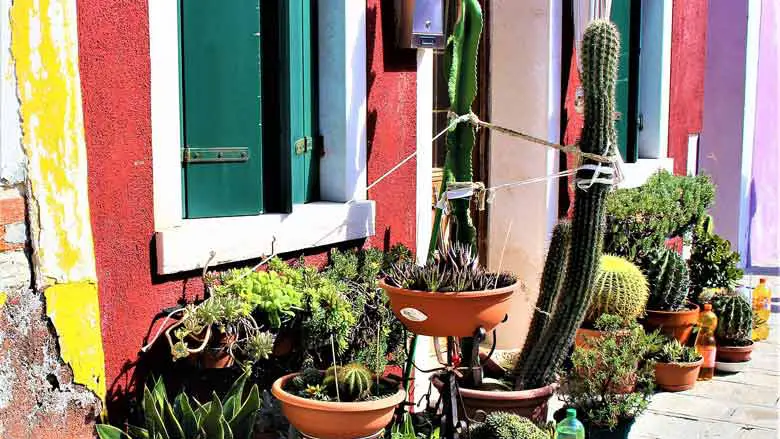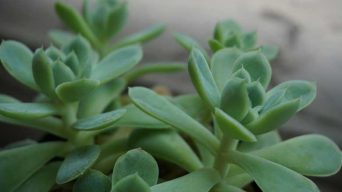Cacti may fall over due to improper pot size, inadequate pot weight, unsuitable soil, over/underwatering, frost damage, top-heaviness, rotting roots, insufficient sunlight, or pest infestation. To prevent this, choose the right pot, use well-draining soil, provide adequate sunlight, and promptly address water and pest issues. Pruning and staking can also enhance stability, ensuring your cactus thrives upright.
Cacti are known for being sturdy plants that can thrive in harsh environments. However, even cacti can succumb to an occasional fall.
So, why is my cactus falling over, and how can I prevent it? There can be various reasons, some more serious than others, but fortunately, there are solutions.
In this blog post, we’ll explore the possible causes of cacti falling over, from issues like improper cactus care to environmental factors, and provide solutions to get your prickly plant back on its feet.
Reasons Your Cactus Might Be Falling Over
There can be various reasons why your cactus is falling over.
Some are more serious than others, but all should be addressed immediately to prevent further damage.
The following are some common reasons cactus plants fall over.
1. Inappropriate Pot Size
Cacti commonly topple due to improper pot sizes. When planted in excessively large pots, cactus roots tend to grow slowly and become spindly. This results in a top-heavy cactus, prone to falling over.
Conversely, a pot that is too small constrains root growth, impeding proper development and, consequently, leading to a cactus becoming unstable and toppling.
The key lies in selecting an appropriately sized pot to ensure optimal root development and stability for your cactus.
How To Fix It
Plant your cactus in a pot of the appropriate size to prevent it from falling over.
A good rule of thumb for repotting cacti is to choose a container at least twice the width of the cactus.
For example, if a cactus is 15 inches (38 centimeters) in width, you should choose a pot that’s at least 30 inches (76 centimeters) wide.
If your cactus has already fallen over, you can correct the problem by transplanting it into a larger pot.
Remove as much old soil as possible and replant it in fresh soil.
You can also add a stake for support until your plant grows new roots and becomes sturdy enough on its own again.
Using stakes will not cause long-term damage to your plant unless they are left in place for too long after the initial problem has been resolved.
Be sure to remove the stake after about three months.
2. Inadequate Pot Weight
If a cactus is not planted in a heavy pot, it can become top-heavy and fall over.
This is often the case with cacti potted in plastic or lightweight terracotta pots.
Cactus pots should be heavy enough to prevent the plant from toppling over in case of strong winds or other environmental factors.
How To Fix It
Be sure to use a heavy pot to prevent your cactus from falling.
The best type of pot for cacti is a heavy terracotta pot. Terracotta pots are long-lasting and porous, which allows them to absorb excess moisture from the soil.
If you prefer plastic pots, you can place a few large stones at the bottom of the pot before adding soil. This will add weight and help keep your plant upright.
If you live in an area with high winds, you may need to take additional steps to secure your cactus.
You can use stakes or tie the plant down with wire or twine.
3. Unsuitable Soil
Cactus plants thrive in well-draining and dry soil. Utilizing heavy or waterlogged soil can impede the cactus’s ability to absorb moisture, leading to instability and potential collapse.
Avoid using unsuitable soils such as clay, loam, and compost. These varieties lack essential drainage properties and contain high nutrient levels that can potentially harm the roots, particularly in the case of compost.
Additionally, heavy or waterlogged soil increases the risk of rot, ultimately resulting in the cactus toppling over and perishing.
Therefore, it is crucial to choose soil with optimal drainage characteristics to ensure the health and longevity of your cactus.
How To Fix It
To prevent your cactus from drooping over, use well-draining soil that is light in weight.
The best soil for cacti is a succulent/cactus soil mix. Also, a good soil mix for cacti is one part potting soil, one part pearlite, and one part coarse sand.
If you have planted your cactus in unsuitable soil, you can correct the problem by transplanting it into a new pot using a well-draining soil mix suitable for cacti.
Be sure to water sparingly until the plant has become re-established in its new pot.
4. Overwatered Cactus
Excessive watering can also lead to the common occurrence of cacti tipping over.
Cactus plants require very little water (usually once every one to two weeks) and cannot tolerate standing water in their soil for long periods.
If you have been watering your cactus too often or using soil that doesn’t drain well, the excess water will cause the soil to become waterlogged, and the plant will be unable to absorb moisture from the ground.
How To Fix It
To safeguard your cactus from toppling due to excess water, refrain from watering until the soil has thoroughly dried between sessions.
Wait at least one week before determining the need for another watering session. Employ well-draining soil and a pot with drainage holes to enhance water flow.
If you suspect overwatering, remedy the situation by letting the cactus dry out for a few days. If excess water persists, reduce it until only half an inch remains at the pot’s bottom to prevent root rot.
During this recovery phase, refrain from watering until the soil dries between sessions.
Ensure proper soil drainage and pot drainage holes to prevent water accumulation around the roots. If your cactus is indoors, promote faster recovery by providing adequate air circulation.
After resolving the issue, use well-draining soil and a container with drainage holes for your cacti.
5. Underwatered Cactus
A cactus may also fall over because it is underwatered.
Lack of water can cause the soil to become dry and hard, making it difficult for roots to absorb moisture from the ground (and therefore, there isn’t enough support for your plant).
Underwatering can also lead to dehydration in plants, causing them to fall and eventually die if left untreated long enough.
How To Fix It
If you suspect your cactus has been underwater, you can fix the problem by watering more often than once every one to two weeks.
Be sure to water until the soil has become wet and drenched, and allow excess water to drain from the pot.
After watering, wait at least one week before deciding whether or not another watering session is needed.
It’s also essential to use a soil that drains well and a pot with drainage holes.
When fixing your underwatered cactus during this period, do not water again until the soil dries out between each watering session.
Be careful not to overwater your cactus in the process!
6. The Cactus Has Frost Damage
Another common reason cacti may fall over is frost damage.
Most cactus plants cannot tolerate temperatures below freezing and will incur frost damage if exposed to these conditions.
Frost damage on a cactus can cause the plant to become weak and brittle, making it difficult for roots to absorb moisture from the ground (and therefore, there isn’t enough support for your plant).
If your cactus has been damaged by frost, you may notice that the leaves have turned brown or black and are wilted.
The cactus plant may also be drooping or leaning due to the loss of structural support from the damaged leaves.
How To Fix It
If your cactus has been damaged by frost, the first thing you can do is to make sure it’s in a safe area where it won’t get hit again.
Move your cactus indoors so that it can recover from frost damage. You can also try to cover it with a blanket or sheet if there is another frost warning in your area.
You should also cut back on watering until new growth starts so as not to overwater them while recovering from the damage caused by frost.
You may also want to try moving it into brighter light conditions, such as under fluorescent lights, during their recovery period.
This will allow more energy production through photosynthesis and speed up the healing process for these plants!
7. Top-Heavy Cactus Plant
Plants are living things, and they grow. As cactus plants get bigger, their weight also increases. This can cause the plant to become top-heavy and fall over time.
The taller the cactus gets, the more likely it will fall over because of its increased height and consequent weight distribution problems (which will affect stability).
Also, the roots of a cactus can only hold so much weight before they start to pull on one side or another, which causes the cactus to fall.
How To Fix It
If you observe your cactus leaning from top-heavy growth, a practical remedy is to redistribute the weight by selectively pruning taller branches.
This enhances the plant’s stability and fosters a more balanced and visually appealing appearance.
This can also help with air circulation around the plant, improving its overall health and stability.
You should also consider repotting your cactus into a larger container to give it more room at its base for root growth!
This will provide better support in future seasons when heavy rainfalls occur or winds emerge again during winter.
If your cactus is still falling, you may want to try to stake it up with a piece of wood or metal pole. This will help to keep it from toppling over in bad weather conditions like storms or heavy winds.
You could also try tying them down using a rope to prevent them from moving around too much in high winds because this method will also anchor them securely!
8. Rotting Roots
One of the main reasons cacti may fall over is root rot.
Root rot is a disease that occurs when roots are too wet for an extended period, which causes them to decay and die.
As the roots weaken from rot damage, they can no longer support the weight of your cactus plant.
How To Fix It
If your cactus has root rot, remove damaged roots and repot the plant in a new potting mix.
Ensure the new pot has good drainage so the weak roots can dry out quickly (this will help stop the rot from spreading).
You should also cut back on watering until new growth starts so as not to overwater them while recovering from the damage caused by root rot.
You may also want to try moving it into brighter light conditions during their recovery period.
This will allow more energy production through photosynthesis and speed up the healing process for these houseplants!
9. The Cactus Doesn’t Get Enough Sunlight
Another reason your cactus may be falling over is that it’s not getting enough sunlight.
Cacti need direct sunlight to stay healthy and grow properly.
If yours isn’t receiving at least six hours of sunlight each day, this could lead to problems such as stunted growth.
Also, they may fall if they’re not getting enough light because this lack of energy production will hinder the growth of their roots.
How To Fix It
If your cactus is falling over due to a lack of sunlight, move it into an area with more direct sun exposure.
This might mean taking them outside during the day and bringing them inside at night so that they can get enough sunlight on both sides!
Cactus need at least six hours of sunlight daily to stay healthy.
However, too much sunlight can also be harmful, so keep an eye on them and move them back inside if they get too much sun.
Also, consider supplementing with grow lights if they’re not getting enough sunlight in their current location.
This will help them grow tall and strong without worrying about falling over!
10. The Cactus Is Infested With Pests
Another plausible explanation for your cactus drooping may be attributed to a pest infestation.
If you notice your cactus falling over, inspect it closely for any signs of pests, as they can weaken the plant’s structure and contribute to its decline.
Pests such as mealybugs, spider mites, and aphids can cause severe damage to cacti plants by sucking the sap out of their tissues (which will make them weak and susceptible to toppling over).
Pests should be treated as soon as possible to not spread to other houseplants in your home or garden (which could lead to more damage).
How To Fix It
If you find a pest infestation on one of your cacti plants, treat it immediately.
Depending on the pest, there are various ways that you can treat it.
For example, mealybugs can be treated with a cotton swab dipped in rubbing alcohol, spider mites can be controlled using horticultural oil or insecticidal soap, and aphids can be killed with neem oil or pyrethrum.
You should also quarantine any new cacti plants before bringing them into your home/garden, just in case hidden insects are lurking within their potting mix.
This will prevent any potential pests from spreading around and causing more problems for you later down the road when those bugs have hatched out inside another plant’s soil!
Mitigating the Risk of Cactus Plants Falling Over
With their distinctive and occasionally top-heavy structures, Cacti are susceptible to tipping over. Implementing preventive measures is crucial to ensuring the stability of your cacti while preserving their aesthetic appeal.
Here are practical steps to minimize the risk of cacti tipping over:
- Select Appropriate Containers: Choose heavy and wide containers to establish a stable base for your cacti. The weight and width of the container play a significant role in preventing toppling.
- Use Well-Draining Soil: Utilize a well-draining soil mix to prevent water accumulation, increasing the container’s weight and impacting the plant’s balance.
- Position Cacti Properly: Place cacti in locations with sufficient light to promote even growth. Ensure the cactus receives sunlight from all sides to prevent leaning in a particular direction.
- Watering Practices: Adopt a controlled watering routine to prevent overwatering, which can weaken root systems and destabilize the plant. Allow the soil to dry out between watering sessions.
- Support Stakes: For taller or delicate cacti varieties, consider using support stakes. Gently tie the cactus to the stake to provide extra support until it can sustain itself.
- Balance Aesthetics with Stability: While arranging cacti for visual appeal, maintain balanced weight distribution among containers to enhance overall stability.
- Prune Wisely: Regularly prune your cacti to eliminate excess growth that may contribute to imbalance. Focus on maintaining a well-proportioned and stable plant structure.
- Monitor Growth: Keep a close eye on the growth patterns of your cacti. If you observe any signs of leaning or instability, promptly take corrective action to prevent further complications.
By incorporating these preventive measures, you can enhance the stability of your cacti and enjoy their unique beauty without the worry of them tipping over.
Remember that a well-maintained and balanced environment is key to the health and longevity of your cacti.
Final Thoughts
Cacti plants are succulents that can be a great addition to any garden or home, but they require some care and attention to stay healthy.
If you notice your cactus falling over, look closely at why and try to correct the problem immediately!
By following these simple tips, you’ll have happy and healthy cactus plants that will add life (and color!) to your space.







